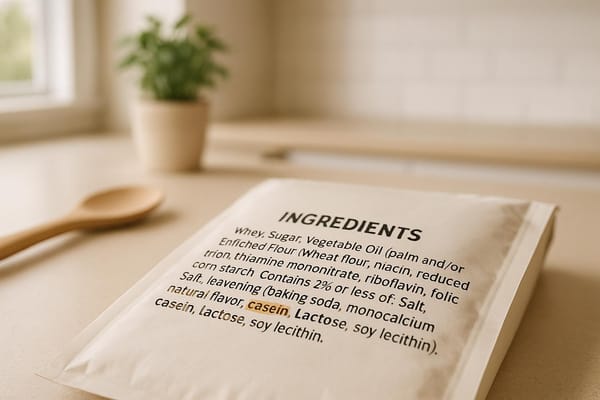Clinical Tests for Lactose Intolerance
Learn about the clinical tests for lactose intolerance, their processes, and how to manage this common digestive issue effectively.

Lactose intolerance is a common issue where the body can't digest dairy properly. To diagnose it, doctors use these main tests:
- Hydrogen Breath Test: Measures hydrogen in your breath after drinking lactose. High levels suggest intolerance.
- Blood Sugar Test: Tracks blood sugar changes after consuming lactose. A small rise may indicate intolerance.
- Stool pH Test: Checks stool acidity, mainly for infants or those unable to do other tests.
- DNA Testing: Identifies genetic factors linked to lactose intolerance.
Each test has specific uses, preparation steps, and benefits. Once diagnosed, managing lactose intolerance can involve enzyme supplements and gradual dairy reintroduction.
| Test Type | Best For | Key Advantage |
|---|---|---|
| Hydrogen Breath Test | Adults and kids over 6 | Non-invasive and reliable |
| Blood Sugar Test | All age groups | Quick and widely available |
| Stool pH Test | Infants and young children | Gentle and easy to perform |
| DNA Testing | Genetic predisposition info | Lifelong results |
Accurate testing and proper management make living with lactose intolerance much easier.
Lactose Intolerance Tests ; Hydrogen Breath Test, Blood Tests ...
1. Hydrogen Breath Test
The hydrogen breath test is a simple, non-invasive way to check for lactose intolerance. It works like this: after drinking a lactose-based beverage, the patient’s breath is measured at regular intervals. If hydrogen levels in the breath are high, it typically points to lactose malabsorption. To get accurate results, patients must follow strict pre-test instructions, though the exact procedure can differ depending on the provider. Let’s move on to another method used to diagnose lactose intolerance.
2. Blood Sugar Test for Lactose
This test helps determine how well your body processes lactose by measuring changes in blood glucose levels over a 2-3 hour period.
Here’s what the process looks like:
- Fasting Period: You'll need to fast for 8-12 hours before the test.
- Initial Blood Draw: A baseline blood sample is taken by a healthcare provider.
- Lactose Drink: You'll drink a solution containing 50 grams of lactose mixed with water.
- Blood Samples: Blood is drawn every 30 minutes for up to 2 hours.
- Results: Changes in your blood sugar levels over time are analyzed.
If your blood sugar rises by 30 mg/dL or more within 2 hours, it indicates your body is digesting lactose normally. If the increase is smaller, it may mean your body isn't breaking down lactose properly, pointing to lactose intolerance.
Things to Keep in Mind
- Avoid dairy for 24 hours before the test.
- Skip morning exercise on test day.
- Continue any prescribed medication unless your doctor advises otherwise.
While the test is safe, some people might feel temporary nausea, bloating, or diarrhea. These symptoms usually go away within a few hours.
Next, we’ll cover stool pH testing, another method to assess lactose intolerance.
3. Stool pH Testing
Stool pH testing measures the acidity in stool to help identify lactose intolerance. It's especially useful for infants and young children who can't undergo breath or blood tests.
How the Test Works
When someone has trouble absorbing lactose, the undigested lactose ferments in the colon, producing lactic acid and other byproducts. This process lowers the stool's pH. A fresh stool sample is analyzed using either pH paper or an electronic pH meter. Typically, stool pH falls between 6.0 and 7.2. A pH reading below 5.5 may suggest lactose malabsorption.
When Doctors Recommend It
Doctors may recommend stool pH testing in specific cases:
- Infants: For babies showing possible reactions to dairy
- Limited Mobility: For patients unable to visit a clinic easily
- Alternative Testing: When breath or blood tests aren’t feasible
This test works alongside other diagnostic tools, such as hydrogen breath or blood sugar tests, to provide a fuller picture.
Test Preparation
You’ll likely be asked to maintain your usual dairy consumption unless told otherwise. Collect a fresh stool sample, keep it at room temperature, and ensure it’s submitted within 30 minutes for accurate results.
Test Limitations
- Results can be affected by diet or other digestive conditions
- Less accurate compared to breath or blood tests
- May require multiple samples for a conclusive diagnosis
Stool pH testing is often used in combination with other clinical evaluations to confirm lactose intolerance. DNA testing can further refine the diagnosis.
4. DNA Testing for Lactose Intolerance
DNA testing is one way to pinpoint genetic variations linked to lactose intolerance. These tests focus on the MCM6 gene, which plays a role in regulating the production of the lactase enzyme.
How Genetic Testing Works
A sample, typically collected through a cheek swab or saliva, is analyzed for specific variations in the MCM6 gene. One key variant, C/T-13910, is often linked to whether someone can digest lactose. This variant is especially common in individuals of European descent.
Results:
- CC Genotype: Likely lactose intolerant
- CT Genotype: Partial ability to digest lactose
- TT Genotype: Lactose tolerant
Advantages of DNA Testing
DNA testing comes with several perks:
- One-Time Test: Since your genetic information doesn’t change, the results are valid for life.
- Non-Invasive: No need to consume lactose or undergo multiple procedures.
- Accurate: The test is highly effective in identifying genetic predispositions.
- Fast Results: Reports are typically delivered quickly.
Limitations of DNA Testing
While helpful, genetic testing does have some limitations:
- Primarily validated for individuals of European ancestry.
- Cannot detect lactose intolerance caused by secondary conditions.
- Does not determine the severity of symptoms.
When DNA Testing Makes Sense
This type of testing can be a good option for:
- Individuals with unclear results from other diagnostic methods.
- Those looking for a definitive answer about lactose intolerance.
- People with a family history of the condition.
- Patients unable to complete breath or blood-based tests.
DNA testing serves as a lifelong reference, complementing other diagnostic tools.
Preparing for the Test
Getting ready for genetic testing is simple:
- No fasting or special diet changes are needed.
- Avoid eating, drinking, or smoking shortly before collecting your sample.
- Carefully follow the instructions provided for sample collection.
The insights from this test can help healthcare providers develop personalized management plans, which will be discussed in the next section.
Treatment Options After Diagnosis
Once lactose intolerance is clinically confirmed, managing it effectively can help you continue enjoying dairy products. A key part of this management is using enzyme supplements designed to aid digestion.
Enzyme Supplementation and Usage
Digestive enzyme supplements can make it easier to digest dairy. For example, milktab's triple-enzyme formula includes the following components:
- 27,000 FCC units of lactase to help break down lactose
- 22,000 FCC units of protease to assist with protein digestion
- 1,000 FCC units of lipase to support fat digestion
These supplements should be taken right before consuming dairy. For safety and optimal results, limit intake to a maximum of two pills per day.
Success Stories from Users
"Milktabs WORK!! I went on a European vacation and ate all the cheeses I wanted to! It was so great to have these tabs!!!!"
"With Milktab, I don't worry about the pill's strength, making dairy enjoyable every time!"
Choosing High-Quality Enzyme Supplements
When selecting enzyme supplements, prioritize products that meet these criteria:
- Tested by third-party labs
- Free from FODMAPs
- Suitable for vegans
- Certified non-GMO
Gradual Dairy Reintroduction
Even with enzyme support, it's a good idea to reintroduce dairy gradually. Pay attention to how your body reacts to determine what works best for you. This approach, combined with enzyme supplementation, can help you manage lactose intolerance more effectively.
Additional Features for Convenience
| Feature | Benefit |
|---|---|
| Compact Size | Easy to carry and use while traveling |
| Multiple Enzymes | Supports digestion of various dairy components |
| High Potency | Requires fewer pills per serving |
| Quality Testing | Ensures product reliability and safety |
Consulting with your healthcare provider can further refine your management plan, as individual responses to treatment can vary.
Key Takeaways
Clinical tests can accurately identify lactose intolerance and help in creating personalized management plans. Here's a breakdown of the testing process and treatment options:
Testing Methods and Their Uses
| Test Type | Advantages | Best For |
|---|---|---|
| Hydrogen Breath Test | Non-invasive and reliable | Adults and children over 6 |
| Blood Sugar Test | Quick results and widely available | All age groups |
| Stool pH Testing | Gentle and suitable for infants | Babies and young children |
| DNA Testing | Identifies genetic predisposition | Individuals with a family history |
From Diagnosis to Treatment
Once diagnosed, healthcare providers can recommend effective treatments. For example, high-strength enzyme supplements like Milktab can help improve dairy digestion.
Key Tips for Management
Here are some important tips for managing lactose intolerance:
- Take enzyme supplements just before eating dairy.
- Limit enzyme supplements to no more than 2 pills per day for safety.
- Opt for supplements that include multiple enzymes for better digestion.
- Pay attention to how your body reacts when reintroducing dairy.
With accurate diagnosis and the right enzyme supplements, managing lactose intolerance becomes much easier.



